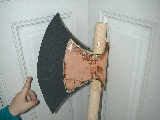SCA Legal 10th Century Viking Axe
This is the new axe that I'm designing for SCA combat. It is modeled on a 10th century Norwegian Viking Axe. I've since come to learn through some research that the bit on the axe is too large in comparison to most of the 10th century finds - have to do some more looking.
The Construction
- Finding the Axe Head
- Rattan and Other Considerations
- Assembly
- Taping and Cosmetics
- Combat Trials
Finding the Axe Head A while ago, Mikhalis sold me a Rathbone axe he'd built using the Mandrake vulcanized rubber axe head. Although it's got good heft, it's a heavy brick of a thing. A while ago, Mikhalis sold me a Rathbone axe he'd built using the Mandrake vulcanized rubber axe head. Although it's got good heft, it's a heavy brick of a thing.
Lucky for me, during the 2004 Spring Crown Tourney for the Middle Kingdom, I ran across a merchant (By My Hand) selling period profile polearm and axe heads. They were selling the axe head and leather wrapping for $15 (on sale from $20). For as light as the axe head felt, it seemed worthwhile to put another axe together.
This photo shows the axe already assembled and bonded. The rubber is very firm, but also fairly light. You can click the picture for a larger view.
Rattan and Other Considerations
Also at Crown tourney, and right next door to the axe merchant, was the vendor Munitions Grade Arms, and they were selling shaved rattan. Shaved rattan has been run through a lathing process (I think) to take it down to 1 1/4" (almost) exactly. You lose the skin of the rattan, but are left with a very light piece. I picked up a 9' length for $15. I drive a fairly small car, so I had to cut the pole down to fit. The short piece seemed just the right length for a mid-hafted axe. Did I mention how light the rattan is? Assembly
 To get the axe assembled, I started by soaking the leather piece overnight in water to make it pliable. It is thick leather, and needed to be soaked so it didn't crack or pull against the glue bond after assembly. After a good soaking, the leather was bent double around the axe head, in the same position it would eventually occupy. The damp leather (soaking, actually) was weighted down with a couple of 5 pound flat weights to ensure it would hold its position.
To get the axe assembled, I started by soaking the leather piece overnight in water to make it pliable. It is thick leather, and needed to be soaked so it didn't crack or pull against the glue bond after assembly. After a good soaking, the leather was bent double around the axe head, in the same position it would eventually occupy. The damp leather (soaking, actually) was weighted down with a couple of 5 pound flat weights to ensure it would hold its position.
A few days later, the leather was dry, so I took it out to the workshop and used a combination of polyurethane glue (not epoxy), clamps, and clamped the assembly together. I took great care to set the axe's position so that any excess glue would drip away from the leather, over the rubber. My reasoning (correctly, as it turns out) was that it would be easier to peel the glue off the surface of the rubber. Polyurethane glue foams as it sets, so there was a fair amount of dripping.
Taping and Cosmetics
Taping was made somewhat more complex because I wanted to minimize the amount tape needed in order to keep the head of the axe light. As it turned out, I spent quite a bit of time cutting tape to fit, but the results were worth it.
The axe uses silver duct tape for the head, and a dark brown duct tape for the haft. Friction tape covers the lengthy grip area.
Combat Trials
My most gracious thanks to Tomas for being the first to allow me to experiment with my new axe. As a new fighter, all of these experiences are novel, and building the axe was a great learning experience in itself. Actually getting to fight with it was a blast. Definitely need to rework the clamshells, though - they don't fit quite right.
My key learning experiences using the axe are
- It is possible to use excessive force more easily with a mass weapon like this. Even though this axe is 8" longer and lighter than my Rathbone axe, it packs more of a wallop - mass x speed, perhaps.
- Shield hooking can be fun, but only if you can get into position to follow it up. I had Tomas' shield so hopelessly out of position I could have skewered him with a shrimp fork, save that I was too slow and out of position myself.
- The axe head's "dimensionality" forces the opponent to block beyond the plane of the haft, which changes how the opponent must block the blows.
- The length of the haft was good for providing some blocking, as I had hoped. It also varied the range of the weapon - at my skill level it doesn't make much difference, but I can see where a more skilled fighter might take advantage of it.
Last Modified: Wednesday, August 25, 2004 11:14.
|






 To get the axe assembled, I started by soaking the leather piece overnight in water to make it pliable. It is thick leather, and needed to be soaked so it didn't crack or pull against the glue bond after assembly. After a good soaking, the leather was bent double around the axe head, in the same position it would eventually occupy. The damp leather (soaking, actually) was weighted down with a couple of 5 pound flat weights to ensure it would hold its position.
To get the axe assembled, I started by soaking the leather piece overnight in water to make it pliable. It is thick leather, and needed to be soaked so it didn't crack or pull against the glue bond after assembly. After a good soaking, the leather was bent double around the axe head, in the same position it would eventually occupy. The damp leather (soaking, actually) was weighted down with a couple of 5 pound flat weights to ensure it would hold its position.